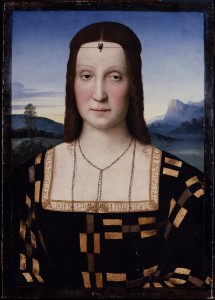
By Koren Whipp
Elisabetta Gonzaga (1471-1526) an Italian noblewoman, leader and salonnière of Urbino, Italy. Born in Mantua, she was the fourth child of Federico I Gonzaga, Marquess of Mantua, and Margherita of Bavaria (Margaret of Wittelsbach). Well-educated, Elisabetta also sang and played music. She married Guidobaldoin 1488. Soon after, it became clear that her husband was impotent. Nevertheless, Elisabetta seems to have had genuine affection for him and was loyal to him throughout his life.[1]
Regardless of his ill health, Guidobaldo was a condottiero, an Italian mercenary contracted by the Italian city-states and the Papacy, and he fought against the French under Charles VIII in Romagna in 1496. Elisabetta was left to govern Urbino in Guidobaldo’s absence and presided over their Urbino salon. Baldassare Castiglione, who served Guidobaldo from 1504-13, depicted Urbino as the ideal Renaissance court in his Libro del Cortigiano (Book of the Courtier) 1528. Castiglione’s inclusion of Elisabetta Gonzaga in this dialogue positions her as an important figure in Italian literary history.[2]
Guidobaldo was forced to flee in 1502 when Cesare Borgia, Duke de Valentinois, and illegitimate son of Pope Alexander VI, occupied Urbino. After successful invasions of Romagna, Borgia tried to usurp the dukedom of Urbino by trying, unsuccessfully, to annul the marriage of Elisabetta and Guidobaldo. However, upon the death of Alexander VI and the waning of Borgia’s power, the couple reestablished their ducal court at Urbino.[3]
In 1504, the couple adopted Francesco Maria I Della Rovere , the son of Giovanni della Rovere and Giovanna da Montefeltro , Giobaldo’s sister. As they were childless, Francesco was chosen by Guidobaldo as successor to the dukedom. Following Guidobaldo’s death in 1508, Elisabetta continued as regent until Francesco came of age.[4]
[1] June Osborne, Urbino: The Story of a Renaissance City (London: Frances Lincoln, 2003), 126.
[2] Elizabeth Pallitto, “Gonzaga, Isabella de,” Mary Hays, Female Biography; or, Memoirs of Illustrious and Celebrated Women, of All Ages and Countries (1803) Chawton House Library Series: Women’s Memoirs, ed. Gina Luria Walker, Memoirs of Women Writers Part II (Pickering & Chatto: London, 2013), vol. 8, 347-48, editorial notes, 581-82, on 581.
[3] Palitto, “Gonzaga, Isabella de,” vol. 8, 347-48, editorial notes, 581-82, on 582.
[4] Baldassare Castiglione, The Book of the Courtier. trans. Leonard Eckstein Opdycke (New York: C. Scribner’s Sons, 1903), 322.
Bibliography
Bayle, Pierre. The Dictionary Historical and Critical of Mr. Peter Bayle. New York: Garland, 1984.
Biographium fæmineum. The female worthies: or, memoirs of the most illustrious ladies, of all ages and nations,…Collected from history, and the most approved biographers,…In two volumes..
London: printed for S. Crowder, and J. Payne; J. Wilkie, and W. Nicoll; and J. Wren, 1766..
Bradford, Sarah. Lucrezia Borgia. Milano: Mondadori, 2005.
Castiglione, Baldassare. The Book of the Courtier. trans. Leonard Eckstein Opdycke. New York: C. Scribner’s Sons, 1903.
Englander, David. Culture and Belief in Europe, 1450-1600: An Anthology of Sources. Oxford, Blackwell, 1990.
Findlen, Paula. The Italian Renaissance: The Essential Readings. Malden, MA: Blackwell, 2002.
Hall, Marcia B. The Cambridge Companion to Raphael. Cambridge University Press, 2005.
Hays, Mary. “Isabella de Gonzaga.” Female Biography; or, Memoirs of Illustrious and Celebrated Women of all Ages and Countries (6 volumes). London: R. Phillips, 1803, vol. 4, 345-46.
Jansen, Sharon L. Debating Women, Politics, and Power in Early Modern Europe. New York: Palgrave Macmillan, 2008.
Osborne, June. Urbino: The Story of a Renaissance City. London: Frances Lincoln, 2003.
Pallitto, Elizabeth. “Gonzaga, Isabella de,” Mary Hays, Female Biography; or, Memoirs of Illustrious and Celebrated Women, of All Ages and Countries (1803) Chawton House Library Series: Women’s Memoirs, ed. Gina Luria Walker, Memoirs of Women Writers Part II. Pickering & Chatto: London, 2013, vol. 8, 347-48, editorial notes, 581-82.
Resources:
Brooklyn Museum
Elizabeth A. Sackler Center for Feminist Art: The Dinner Party: Heritage Floor: Elizabetta Gonzaga
http://www.brooklynmuseum.org/eascfa/dinner_party/heritage_floor/elizabetta_gonzaga.php
Page citation:
Koren Whipp. “Elisabetta Gonzaga.” Project Continua (January 31, 2014): Vol. 1, [date accessed], http://www.projectcontinua.org/elisabetta-gonzaga/
Tags: End of Renaissance, Europe, Reformation, Salonnières
